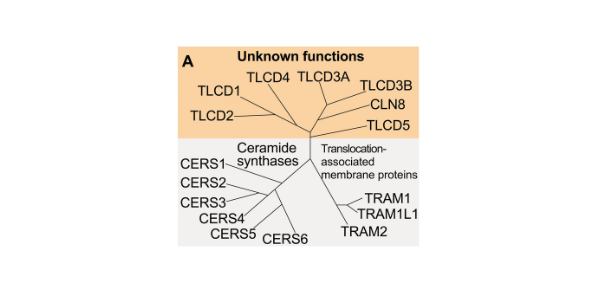
Submitted by Penny Peck on Thu, 06/03/2025 - 11:51
Phospholipids, the fundamental building blocks of cellular membranes, are continuously remodelled to ensure membrane integrity and function. A new study from the lab of Dr Kasparas Petkevicius at the MRC Mitochondrial Biology Unit, published in Science Advances, demonstrates that TRAM-LAG1-CLN8 (TLC) family proteins function as phospholipid remodelling enzymes, adding to the previously known MBOAT and AGPAT families of phospholipid remodelling proteins. The researchers show that TLCD1, a key member of this family, acts as a lysophosphatidylethanolamine (LPE) acyltransferase with a preference for monounsaturated fatty acids, thereby maintaining the composition of cellular phosphatidylethanolamine (PE) - a phospholipid enriched in mitochondria and essential for proper mitochondrial function. Loss of TLCD1 alters the phospholipid profile of cells and their mitochondria, underscoring its vital role in membrane homeostasis.
Unexpectedly, the study also finds that TLCD1 generates fatty acyl-thiamine (vitamin B1) esters in yeast and human cells cultured in thiamine-rich conditions, although the biological significance of these molecules remains unknown. Further experiments in yeast and nematodes reveal that the function of TLCD1 is evolutionarily conserved: the yeast protein YPR114w (now named ALE2) and the C. elegans homolog FLD-1 both remodel LPE, each with distinct fatty acid preferences.
Importantly, the researchers uncovered that another TLC family member, CLN8 - a protein associated with Batten disease - is a lysophosphatidylglycerol acyltransferase responsible for a critical step in the synthesis of bis(monoacylglycero)phosphates (BMPs), a class of phospholipids essential for lysosomal function. CLN8-deficient human cells fail to produce BMPs, raising the possibility that defective BMP synthesis may drive Batten disease pathology. Ongoing work in the Petkevicius lab aims to clarify the link between BMP production and Batten disease progression, offering new avenues for potential therapies.
Reference
Sheokand PK, James AM, Jenkins B, K Lysyganicz P, Lacabanne D, King MS, Kunji ERS, Siniossoglou S, Koulman A, Murphy MP, Petkevicius K. TRAM-LAG1-CLN8 family proteins are acyltransferases regulating phospholipid composition. Sci Adv. 2025 Feb 21;11(8):eadr3723. doi: 10.1126/sciadv.adr3723.

